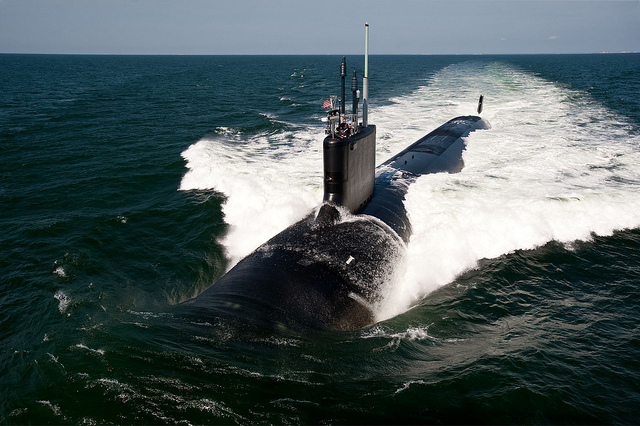It's been just a couple of months since the Bipartisan Budget Act of 2015 was passed by the Congress and signed by the president. Spending levels for the current year for the Pentagon were set at $548 billion for the so-called “base budget” and $59 billion for the Overseas Contingency Operations (or war-fighting budget). Add those up, and a robust $607 billion is dedicated to the Pentagon for fiscal year 2016.
Remember that this was a two-year agreement, and the fiscal year 2017 figures were set at $551 billion for the base budget and no less than $59 billion for the war budget (for a grand total of $610 billion). And notice that the war budget language was written as a “floor” and could still be amended upward. Add all those staggering figures up, and we plan to spend well over a trillion dollars on the Department of Defense in this year and next.
 |
| The USS California, a Virginia-class submarine |
The bill was signed on Oct. 30, and in a speech on Jan. 13, the chairman of the House Armed Services Committee, Rep. Mac Thornberry, said, “Last fall's budget agreement does not provide enough money for defense.”
Rep. Thornberry's speech goes on to enumerate items he believes should receive emphasis within the Pentagon budget, including dedicating as much as 5 percent of the defense budget to ensure an effective nuclear deterrent. And one of the major cost drivers of procurement spending (not overall Pentagon spending) is the current plan to modernize all three legs of the nuclear triad: replacing the Ohio class submarine with the SSBN-X, a new Long Range Strike Bomber, and a new land-based intercontinental ballistic missile.
In fact, Thornberry's committee, two years ago, created the so-called National Sea-Based Deterrence Fund to take the cost of the new ballistic missile submarine out of the Navy's budget and purchase it, instead, in this new fund in the budget of the Office of the Secretary of Defense. I've written about this transparently ridiculous idea many times over the past two years. The armed services committees can create it, but only the appropriations committees can allow money to be put in the fund, and thankfully so far they've declined. As it stands, the National Sea-Based Deterrence Fund and 25 cents will buy you a piece of bubble gum.
But one of the major reasons cited by the members of Congress who support this special fund is that the Navy's shipbuilding budget in the future will be strained by the new aircraft carrier and the continuation of the Virginia-class of fast attack submarine. According to this line of thought, the shipbuilding budget will be so constrained in the 2020s that one or more of these programs will have to be curtailed if special funding isn't in place. In fact, a newly released study by Todd Harrison at the Center for Strategic and International Studies debunks this argument. Entitled “Defense Modernization Through the 2020s: Addressing the Bow Wave,” Harrison shows that Navy planning for its shipbuilding budget fits all of its ship programs into its current plan for the Navy budget. In fact, no huge increase is needed to shipbuilding due to the timing built into the Navy plans for the two submarine programs.
Likewise, Department of the Navy planning for its Navy and Marine Corps aircraft programs has been managed so that there is no significant “bow wave” required to recapitalize aircraft – even though the hugely expensive F-35 takes a large and long-term bite out of the aircraft budget.
But Harrison's report does show an alarming bow wave coming in the Air Force as it ramps up to buy its version of the F-35, the new Long-Range Strike Bomber and the new tanker. For scale, in fiscal year 2015, the Air Force spent about $12 billion on the research, development and procurement of all of its major aircraft programs – 14 different types of airframes, including unmanned vehicles. The current plan is to spend close to $17 billion on just the fighter, bomber and tanker in fiscal year 2023 – add all the rest of the airframes and the Air Force would have to have close to $23 billion that year to afford all of its currently planned major aircraft programs. In other words, the Air Force will need to almost double the amount of money it devotes to aircraft to meet the current plan.
The ability of the military services (and any government agency) to live within a budget and prioritize is certainly hampered by the repeated congressional failure to consistently pass appropriations bills on time. But a little planning can go a long way. We need both Congress and all the branches of the military to make their acquisition plans based on the reality that our budgets are limited.










